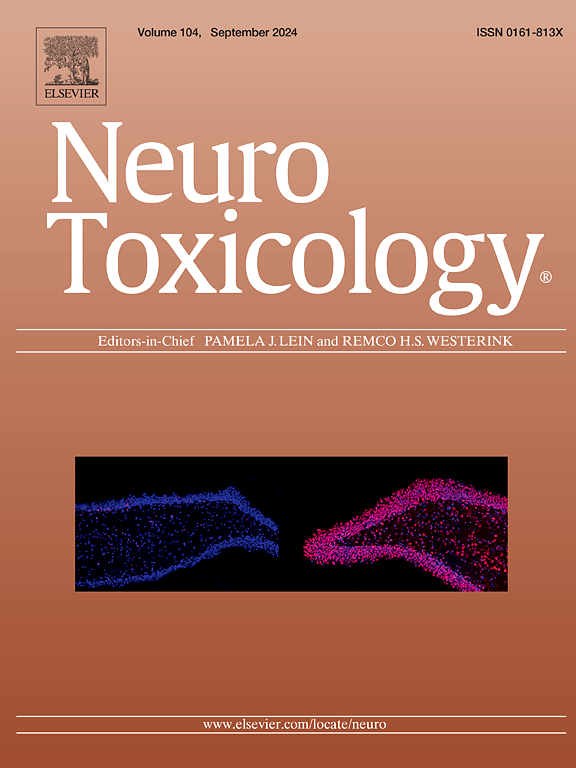Using machine learning to investigate the influence of the prenatal chemical exposome on neurodevelopment of young children
IF 3.9
3区 医学
Q2 NEUROSCIENCES
引用次数: 0
Abstract
Research investigating the prenatal chemical exposome and child neurodevelopment has typically focused on a limited number of chemical exposures and controlled for sociodemographic factors and maternal mental health. Emerging machine learning approaches may facilitate more comprehensive examinations of the contributions of chemical exposures, sociodemographic factors, and maternal mental health to child neurodevelopment. A machine learning pipeline that utilized feature selection and ranking was applied to investigate which common prenatal chemical exposures and sociodemographic factors best predict neurodevelopmental outcomes in young children. Data from 406 maternal-child pairs enrolled in the APrON study were used. Maternal concentrations of 32 environmental chemical exposures (i.e., phthalates, bisphenols, per- and polyfluoroalkyl substances (PFAS), metals, trace elements) measured during pregnancy and 11 sociodemographic factors, as well as measures of maternal mental health and urinary creatinine were entered into the machine learning pipeline. The pipeline, which consisted of a RReliefF variable selection algorithm and support vector machine regression model, was used to identify and rank the best subset of variables predictive of cognitive, language, and motor development outcomes on the Bayley Scales of Infant Development-Third Edition (Bayley-III) at 2 years of age. Bayley-III cognitive scores were best predicted using 29 variables, resulting in a correlation coefficient of r = 0.27 (R2=0.07). For language outcomes, 45 variables led to the best result (r = 0.30; R2=0.09), whereas for motor outcomes 33 variables led to the best result (r = 0.28, R2=0.09). Environmental chemicals, sociodemographic factors, and maternal mental health were found to be highly ranked predictors of cognitive, language, and motor development in young children. Our findings demonstrate the potential of machine learning approaches to identify and determine the relative importance of different predictors of child neurodevelopmental outcomes. Future developmental neurotoxicology research should consider the prenatal chemical exposome as well as sample characteristics such as sociodemographic factors and maternal mental health as important predictors of child neurodevelopment.
利用机器学习研究产前化学物质暴露对幼儿神经发育的影响
调查产前化学品接触和儿童神经发育的研究通常侧重于有限数量的化学品接触,并控制社会人口因素和产妇心理健康。新兴的机器学习方法可能有助于更全面地研究化学品暴露、社会人口因素和母亲心理健康对儿童神经发育的影响。利用特征选择和排序的机器学习管道被应用于研究哪些常见的产前化学暴露和社会人口因素最能预测幼儿的神经发育结果。数据来自于参与APrON研究的406对母子。将怀孕期间测量的32种环境化学物质(即邻苯二甲酸盐、双酚类、全氟和多氟烷基物质、金属、微量元素)的母体浓度和11种社会人口因素,以及母体心理健康和尿肌酐的测量纳入机器学习管道。该管道由RReliefF变量选择算法和支持向量机回归模型组成,用于识别和排序2岁时Bayley婴儿发育量表第三版(Bayley- iii)中预测认知、语言和运动发展结果的最佳变量子集。使用29个变量预测Bayley-III认知评分效果最佳,相关系数r = 0.27 (R2=0.07)。对于语言结果,45个变量导致最佳结果(r = 0.30;R2=0.09),而对于运动结果,33个变量导致最佳结果(r = 0.28,R2=0.09)。环境化学物质、社会人口因素和母亲心理健康被发现是幼儿认知、语言和运动发展的高度预测因素。我们的研究结果证明了机器学习方法在识别和确定儿童神经发育结果的不同预测因素的相对重要性方面的潜力。未来的发育神经毒理学研究应考虑产前化学物质暴露以及社会人口因素和母亲心理健康等样本特征作为儿童神经发育的重要预测因素。
本文章由计算机程序翻译,如有差异,请以英文原文为准。
求助全文
约1分钟内获得全文
求助全文
来源期刊

Neurotoxicology
医学-毒理学
CiteScore
6.80
自引率
5.90%
发文量
161
审稿时长
70 days
期刊介绍:
NeuroToxicology specializes in publishing the best peer-reviewed original research papers dealing with the effects of toxic substances on the nervous system of humans and experimental animals of all ages. The Journal emphasizes papers dealing with the neurotoxic effects of environmentally significant chemical hazards, manufactured drugs and naturally occurring compounds.
 求助内容:
求助内容: 应助结果提醒方式:
应助结果提醒方式:


